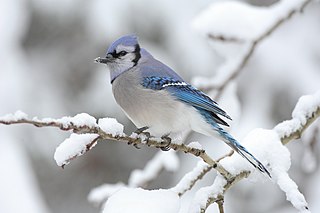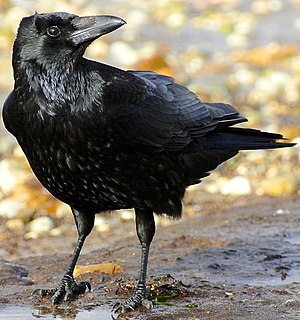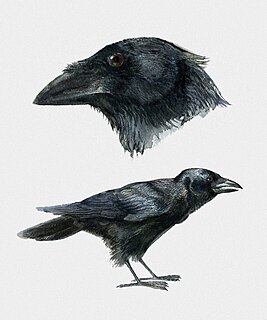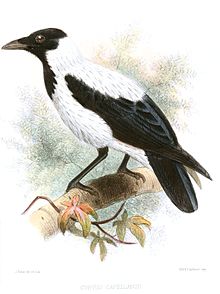
Corvidae is a cosmopolitan family of oscine passerine birds that contains the crows, ravens, rooks, jackdaws, jays, magpies, treepies, choughs, and nutcrackers. In common English, they are known as the crow family, or, more technically, corvids. Over 120 species are described. The genus Corvus, including the jackdaws, crows, rooks, and ravens, makes up over a third of the entire family. Corvids are the largest passerines.

The carrion crow is a passerine bird of the family Corvidae and the genus Corvus which is native to western Europe and the eastern Palearctic.

The hooded crow is a Eurasian bird species in the genus Corvus. Widely distributed, it is also known locally as Scotch crow and Danish crow. In Ireland, it is called caróg liath or grey crow, as it is in the Slavic languages and in Danish. In German, it is called "mist crow" ("Nebelkrähe"). Found across Northern, Eastern, and Southeastern Europe, as well as parts of the Middle East, it is an ashy grey bird with black head, throat, wings, tail, and thigh feathers, as well as a black bill, eyes, and feet. Like other corvids, it is an omnivorous and opportunistic forager and feeder.

The Australian raven is a passerine bird in the genus Corvus native to much of southern and northeastern Australia. Measuring 46–53 centimetres (18–21 in) in length, it has all-black plumage, beak and mouth, as well as strong grey-black legs and feet. The upperparts are glossy, with a purple, blue, or green sheen, and its black feathers have grey bases. The Australian raven is distinguished from the Australian crow species by its throat hackles, which are prominent in adult birds. Older adult individuals have white irises, younger adults have white irises with an inner blue rim, while younger birds have dark brown irises until fifteen months of age, and hazel irises with an inner blue rim around each pupil until age two years and ten months. Nicholas Aylward Vigors and Thomas Horsfield described the Australian raven in 1827, its species name (coronoides) highlighting its similarity with the carrion crow. Two subspecies are recognized, which differ slightly in calls and are quite divergent genetically.

The house crow, also known as the Indian, greynecked, Ceylon or Colombo crow, is a common bird of the crow family that is of Asian origin but now found in many parts of the world, where they arrived assisted by shipping. It is between the jackdaw and the carrion crow in size but is slimmer than either. The forehead, crown, throat and upper breast are a richly glossed black, whilst the neck and breast are a lighter grey-brown in colour. The wings, tail and legs are black. There are regional variations in the thickness of the bill and the depth of colour in areas of the plumage.

The American crow is a large passerine bird species of the family Corvidae. It is a common bird found throughout much of North America. American crows are the New World counterpart to the carrion crow and the hooded crow. Although the American crow and the hooded crow are very similar in size, structure and behavior, their calls are different. The American crow, nevertheless, occupies the same role that the hooded crow does in Eurasia.

The northwestern crow is an all-black passerine bird of the crow genus native to the northwest of North America. It is very similar to the more western forms of the widespread American crow, but it averages slightly smaller allegedly with proportionately smaller feet and a slightly more slender bill. This taxon is perhaps impossible to identify in the field, and is largely identified by range, though even that method is contested.

Lake Tharthar, and known in Iraq as Buhayrat ath-Tharthar, is an artificial lake opened in 1956, situated 100 kilometers northwest of Baghdad between the Tigris and the Euphrates rivers.

A crow is a bird of the genus Corvus, or more broadly a synonym for all of Corvus. The word "crow" is used as part of the common name of species including:

The palm crow is a relatively small corvid that occurs mostly on the Caribbean island of Hispaniola. It was formerly quite frequent on Cuba but has become severely reduced in number. This subspecies is slightly smaller and is usually separated as a subspecies called Corvus palmarum minutus. Both subspecies are usually now given the respective common names of Hispaniolan palm crow and Cuban palm crow to distinguish them.
The New Zealand raven was native to the North Island and South Island of New Zealand but has been extinct since the 16th century. There were two subspecies: the North Island raven and the South Island raven. Another closely related species, the Chatham raven, occurred on the Chatham Islands.

The Mesopotamian Marshes, also known as the Iraqi Marshes, are a wetland area located in Southern Iraq and Southwestern Iran. Historically the marshlands, mainly composed of the separate but adjacent Central, Hawizeh and Hammar Marshes, used to be the largest wetland ecosystem of Western Eurasia. It is a rare aquatic landscape in the desert, providing habitat for the Marsh Arabs and important populations of wildlife. Draining of portions of the marshes began in the 1950s and continued through the 1970s to reclaim land for agriculture and oil exploration. However, in the late 1980s and 1990s, during the presidency of Saddam Hussein, this work was expanded and accelerated to evict Shia Muslims from the marshes. Before 2003, the marshes were drained to 10% of their original size. After the fall of Hussein's regime in 2003, the marshes have partially recovered but drought along with upstream dam construction and operation in Turkey, Syria and Iran have hindered the process. Since 2016 the Mesopotamian marshes have been listed as an UNESCO Heritage Site.
The Bismarck crow is a species of crow found in the Bismarck Archipelago. It was considered by many authorities to be a subspecies of the Torresian crow, but is now treated as a distinct species.
The Royston Crow is a newspaper published in Royston, Hertfordshire, England. It was founded by John Warren in 1855. The newspaper is now a weekly publication, part of the Archant group. The newspaper's name is taken from a local name for the bird hooded crow.
Royston Crow may refer to:

The Indian jungle crow is a species of crow found across the Indian Subcontinent south of the Himalayas. It is very common and readily distinguished from the house crow, which has a grey neck. In the past the species was treated as a subspecies of another crow species, but vocalizations and evidence from ectoparasite co-evolution and phylogenetic evidence have led to it being considered as a distinct species in modern taxonomic treatments. It differs in its voice from the large-billed crow found in the higher elevations of the Himalayas and the eastern jungle crow overlaps in the eastern part of its range. In appearance, it can be difficult to distinguish from either of these species although the plumage tends to be more uniformly glossed in purple and has a longer bill with a fine tip and a less arched culmen. The Himalayan species has a slightly wedge-shaped tail, unlike the rounded tail of the Indian jungle crow and tends to glide a lot.

The Somali crow, or dwarf raven, is approximately the size of the carrion crow, Corvus corone but with a longer bill and a somewhat more brownish cast to the feathers, especially when worn.

The eastern carrion crow is a member of the crow family and a subspecies of the carrion crow. Differences from the nominate subspecies include a larger size, at a length about 500 millimetres (20 in), and more graduated outer tail feathers. The eastern carrion crow is found in Siberia from the Yenisei to Japan, south to Central Asia, Afghanistan, Eastern Iran, Kashmir, Tibet and northern China. They generally lay three to five eggs in trees or buildings. The eggs show no difference from the nominate subspecies.

Sawa Lake is an Endorheic basin located in the Iraqi governorate of Muthanna near to the Euphrates River, some 23 kilometres (14 mi) to the west of Al-Samawa city. This lake has no inlet or outlet, but it draws water from the Euphrates through a system of joint cracks and fissures which transport water to aquifers beneath it. The water's level fluctuates during dry and wet seasons but does not dry up because of the equilibrium state between water feed and evaporation.














